
That said, there is still a fair amount of uncertainty - and a wider-than-usual spread in the cone - for where Ian may be two days from now. Further shifts in the track (east or west) are still possible.
Should Ian stay on this track, the storm surge in the bay could exceed 10 feet (see map below). If Ian should curve a little further east, and make landfall south of Tampa, some of this surge would be reduced. But coastal flooding is going to be a big story with this storm, either way.
All things being even, it is better to be on the left (weaker) side of a land falling hurricane, particularly on the coast.
This morning's KEY MESSAGES from the NHC follow, after which I'll have a brief personal postscript.But the swath of destruction from a major hurricane can be 100 miles wide or more, and extend inland for hundreds of miles, meaning that you don't have to be hit directly to be impacted.

While there may still be a reprieve for me, this morning's track puts a slightly weakened Ian on top of my humble abode around noon on Thursday.
This will be my second evacuation in 5 years, and while it is always difficult, I'm thankful I have a comfortable place to go, and won't be sleeping on a gymnasium floor at a public shelter.
I'm also glad I've embraced a `preparedness lifestyle', and have solar panels, USB batteries, LED lights, a NWS Emergency radio, and other preps to get me - and my `buddy' - through a prolonged grid down situation (see #NPM21: The Neverending Road To Preparedness).
While it is Florida that is under the gun today, tomorrow or next week it could be California, or New York, or somewhere in the American Midwest. Disasters can strike with little or no warning anywhere in the world.
So . . if a disaster struck your region today, and the power went out, stores closed their doors, and water stopped flowing from your kitchen tap for the next 7 to 14 days . . . you are you prepared with:
- A battery operated NWS Emergency Radio to find out what was going on, and to get vital instructions from emergency officials
- A decent first-aid kit, so that you can treat injuries
- Enough non-perishable food and water on hand to feed and hydrate your family (including pets) for the duration
- A way to provide light when the grid is down.
- A way to cook safely without electricity
- A way to purify or filter water
- A way to handle basic sanitation and waste disposal.
- A way to stay cool (fans) or warm when the power is out.
- A small supply of cash to use in case credit/debit machines are not working
- An emergency plan, including meeting places, emergency out-of-state contact numbers, a disaster buddy, and in case you must evacuate, a bug-out bag
- Spare supply of essential prescription medicines that you or your family may need
- A way to entertain yourself, or your kids, during a prolonged blackout
If not, you've got some important work to do. Some good places to get started include:
FEMA http://www.fema.gov/index.shtm
READY.GOV http://www.ready.gov/AMERICAN RED CROSS http://www.redcross.org/
